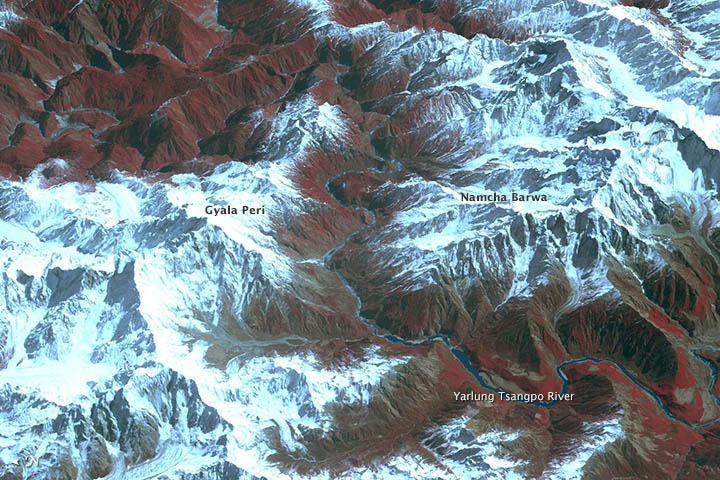NASA: China - Tibet - Yarlung Tsangpo: The Everest of Rivers - 9.03.13
Posted by Ricardo Marcenaro | Posted in NASA: China - Tibet - Yarlung Tsangpo: The Everest of Rivers - 9.03.13 | Posted on 15:47
Adventurers call Tibet’s Yarlung
Tsangpo the “Everest of Rivers” for good reason. Stretches of it are
some of the least-explored places in the world, and tales of failed expeditions
abound. With headwaters in western Tibet near Mount Kailash, the river
has the highest average elevation—4,000 meters (13,000 feet)—of any
major river in the world.
For much of the river’s 3,000 kilometer (1,800 mile) course, it flows east through open valleys on the Tibetan Plateau. But at the eastern end of the Himalayas in southeastern Tibet, the river bends sharply, rushes through one of most dramatic gorges in the world, and descends to the lowlands of the Ganges Delta.
The Yarlung Tsangpo gorge is defined by superlatives. Carved into granitic bedrock, it reaches more than 5,300 meters (17,000 feet) from top to bottom in some places, making it three times deeper than the Grand Canyon. It’s also one of the world’s longest canyons, stretching more than 500 kilometers (300 miles).
The image above shows one of the most inaccessible and rugged sections, a part near the canyon entrance where the river passes between two major peaks: the 7,782-meter (25,446-foot) Namcha Barwa and the 7,294-meter (23,462-foot) Gyala Peri.
The image above is a composite, draping a false-color view from February 25, 2004, over a three-dimensional model of the area. The images and stereoscopic data behind the model were acquired by the Advanced Thermal Emission and Reflection Radiometer (ASTER) on NASA’s Terra spacecraft. Vegetated areas range in color from red to pink; snow is white; water is black; and bare rock is earth-toned.
In 2002, a group of seven people led by filmmaker Scott Lindgren set out to become the first party to kayak the upper gorge. While previous attempts had ended in tragedy, Lindgren’ group prevailed after 45 harrowing days on the water. They didn’t do it alone, though. A team of 93 others accompanied them on land, carrying food and supplies.
They also had help from above. The heart of the gorge is so inaccessible that maps weren’t available when they were planning the expedition. To prepare, Lindgren’s team spent dozens of hours poring over satellite imagery of every mile of the river. “You know you’re screwed when you’re scouting from space,” one of the kayakers joked to Outside magazine.
For much of the river’s 3,000 kilometer (1,800 mile) course, it flows east through open valleys on the Tibetan Plateau. But at the eastern end of the Himalayas in southeastern Tibet, the river bends sharply, rushes through one of most dramatic gorges in the world, and descends to the lowlands of the Ganges Delta.
The Yarlung Tsangpo gorge is defined by superlatives. Carved into granitic bedrock, it reaches more than 5,300 meters (17,000 feet) from top to bottom in some places, making it three times deeper than the Grand Canyon. It’s also one of the world’s longest canyons, stretching more than 500 kilometers (300 miles).
The image above shows one of the most inaccessible and rugged sections, a part near the canyon entrance where the river passes between two major peaks: the 7,782-meter (25,446-foot) Namcha Barwa and the 7,294-meter (23,462-foot) Gyala Peri.
The image above is a composite, draping a false-color view from February 25, 2004, over a three-dimensional model of the area. The images and stereoscopic data behind the model were acquired by the Advanced Thermal Emission and Reflection Radiometer (ASTER) on NASA’s Terra spacecraft. Vegetated areas range in color from red to pink; snow is white; water is black; and bare rock is earth-toned.
In 2002, a group of seven people led by filmmaker Scott Lindgren set out to become the first party to kayak the upper gorge. While previous attempts had ended in tragedy, Lindgren’ group prevailed after 45 harrowing days on the water. They didn’t do it alone, though. A team of 93 others accompanied them on land, carrying food and supplies.
They also had help from above. The heart of the gorge is so inaccessible that maps weren’t available when they were planning the expedition. To prepare, Lindgren’s team spent dozens of hours poring over satellite imagery of every mile of the river. “You know you’re screwed when you’re scouting from space,” one of the kayakers joked to Outside magazine.
References
- China Development Gateway (n.d.) The World’s Biggest Canyon. Accessed March 1, 2013.
- Fisher, R. (n.d.) Canyonlands of Tibet and Central Asia. Accessed March 1, 2013.
- Outside (2004, June 28) Liquid Thunder. Accessed March 1, 2013.
- NASA (n.d.) Yarlung Tsangpo River in China. Accessed March 1, 2013.
- National Geographic (n.d.) Dream Trip: Kayak the Entire Yarlung Tsangpo, Tibet. Accessed March 1, 2013.
- PR Newswire (2004, May 23) Space Imaging’s IKONOS Satellite Images Prove Crucial for Tsangpo River Expedition in Tibet. Accessed March 1, 2013.
- San Francisco Chronicle (2004, Nov 28) River Man: Exploring the World by Kayak—and Documenting the Results. Accessed March 1, 2013.
Related Video
- Lindgren, S. (2002) Into the Tsangpo Gorge. Accessed March 1, 2013.
NASA image courtesy of GSFC/METI/ERSDAC/JAROS, and the U.S./Japan ASTER Science Team. Caption by Adam Voiland.
- Instrument:
- Terra - ASTER
NASA: China - Tibet - Yarlung Tsangpo: The Everest of Rivers - 9.03.13



Comments (0)
Publicar un comentario